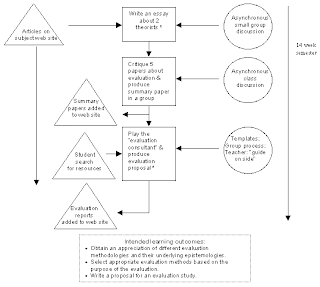During lecture, Mr Alfred showed us videos and explained to us about the 3 theories, Behaviorism,Cognitivism and SocioCultural Approach.It is mandatory that we understand these approaches as they still form the foundation of learning.Furthermore, a good understanding of the theories will help further enhance learning through appropriate changes in pedagogy.I also feel that it is highly interesting to apply these social psychology theories into today's modern world of E-learning.
BehaviorismBehaviorism is described as a developmental theory that measures observable behaviors produced by a learner’s
response to stimuli. Responses to stimuli can be reinforced with positive or negative feedback to condition desired behaviors. Punishment is sometimes used in eliminating or reducing incorrect actions, followed by clarifying desired actions. Educational effects of behaviorism are key in developing basic skills and foundations of understanding in all subject areas and in classroom management. According to behaviorism, knowing is giving the correct response when exposed to a particular stimulus. The behaviorist is not concerned with how or why knowledge is obtained, but rather if the correct response is given.
In terms of the concept of learning, the process tends to be
passive with regard to the behaviorist theory. The learner uses
low level processing skills to understand material and the material is often isolated from real-world contexts or situations. Little responsibility is placed on the learner concerning his/her own education.Typical classroom instruction consistent with the behaviorist theory includes;
classroom management,
rote memorization, and
drill and practice. One example that could be used to show behaviorism would be using a token system to reinforce positive academic performance and student behavior in a classroom. A classroom application of using drill and practice includes computer software, such as Math Blaster’s or any other software. These types of software provide positive and negative reinforcements for answering math problems correctly or incorrectly. A final example highlighting the behaviorist theory is rote memorization. Rote memorization may include memorizing addition or multiplication facts or memorizing state capitals.
Strengths : The learner is focused on a clear goal and can respond automatically to the cues of that goal.Weaknesses: The learner may find themselves in a situation where the stimulus for the correct response does not occur, therefore the learner cannot respond.
CognitivismThe cognitivist paradigm essentially argues that the “black box” of the mind should be opened and understood. The learner is viewed as an information processor. The cognitivist revolution replaced behaviorism in 1960s as the dominant paradigm. Cognitivism focuses on the inner mental activities – opening the
“black box” of the human mind is valuable and necessary for understanding how people learn. Mental processes such as thinking, memory, knowing, and problem-solving need to be explored. Knowledge can be seen as schema or symbolic mental constructions. Learning is defined as change in a learner’s schemata.
Contrary to the behaviorism theory, the theory of Cognitivism states that people are not “programmed animals” that merely respond to environmental stimuli; people are rational beings that require
active participation in order to learn, and whose actions are a consequence of thinking. Changes in behavior are observed, but only as an indication of what is occurring in the learner’s head. Cognitivism uses the metaphor of the mind as computer:
information comes in, is being processed, and leads to certain outcomes. An example would be the different ways in which people react to their surroundings or to different problems because we each have a different set of thinking.This set of thinking might also change after we recieve other inputs.
Strengths: The goal is to train learners to do a task the same way to enable consistency, it may be important do an exact routine to avoid problems.Weaknesses: The way learner learned to accomplish a task, may not be the best way, or suited to the learner or the situation.
SocioCultural ApproachSocioculturalism differs from the other 2 theories as firstly, the unit of analysis is not the individual organism or the individual learner but a
whole system of things. Socioculturalism deals with
social interaction and
cultural understanding. People are equipped with tools like language and are able to learn through the interaction with their environment and other people as well as through
collaboration, therefore in a way, people interact with a whole system of things, rather than just educator and learner. Examples of socioculturalism would be an organization which consists of general workers and managers who understand the organisation's core values and are working towards a common goal and basically any other sort of environment which requires
teamwork.
Strengths: The learner is better able to deal with real life situations, and may better apply their existing knowledge to dynamic situation.Weaknesses: In a situation where conformity is essential divergent thinking and action may cause problems.As Learning is complex and multi-dimensional, I feel that these three theories have to be interwoven to gain a clearer and more in-depth picture of our environment.As there are multiple realities and the environment is made up of a multitude of elements and real-life situations present themselves differently all the time,I feel that to fully understand life, our environment and its complxities,all theories should be applied together and that no one theory can exist on its own.
The three blogs I viewed are :
http://leeweining.blogspot.com/http://iheartnm3204.blogspot.com/http://sandeepbhandal.blogspot.com/The blog that I commented on is :
http://sandeepbhandal.blogspot.com/
 lution evaluation.
lution evaluation. 


